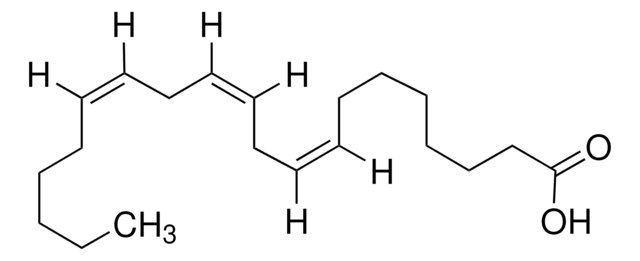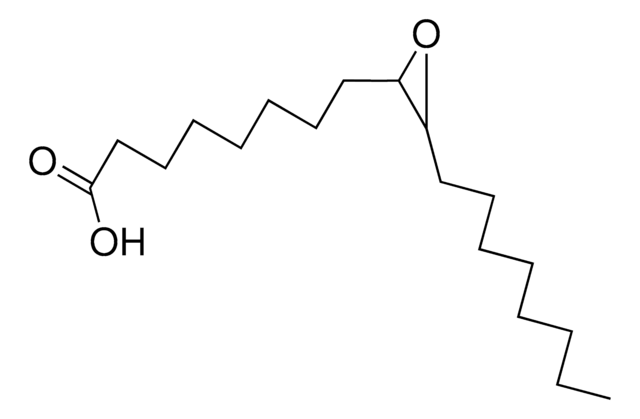추천 제품
Quality Level
분석
≥95%
농도
~100 μg/mL in ethanol
지질 유형
omega FAs
저장 온도
−20°C
SMILES string
CCCCC\C=C\CC1OC1C\C=C\C\C=C\CCCC(O)=O
InChI
1S/C20H32O3/c1-2-3-4-5-9-12-15-18-19(23-18)16-13-10-7-6-8-11-14-17-20(21)22/h6,8-10,12-13,18-19H,2-5,7,11,14-17H2,1H3,(H,21,22)/b8-6+,12-9+,13-10+
InChI key
DXOYQVHGIODESM-ATELOPIESA-N
포장
Packaged under argon
신호어
Danger
유해 및 위험 성명서
Hazard Classifications
Eye Irrit. 2 - Flam. Liq. 2
Storage Class Code
3 - Flammable liquids
WGK
WGK 1
Flash Point (°F)
48.2 °F - closed cup
Flash Point (°C)
9 °C - closed cup
L Yang et al.
British journal of clinical pharmacology, 80(1), 28-44 (2015-02-07)
There is increasing evidence suggesting that epoxyeicosatrienoic acids (EETs) play an important role in cardioprotective mechanisms. These include regulating vascular tone, modulating inflammatory responses, improving cardiomyocyte function and reducing ischaemic damage, resulting in attenuation of animal models of cardiovascular risk
Yong Zhou et al.
Shock (Augusta, Ga.), 47(5), 638-645 (2016-10-19)
Acute lung injury (ALI) is characterized by rapid alveolar injury, vascular leakage, lung inflammation, neutrophil accumulation, and induced cytokines production leading to lung edema. The mortality rate of patients suffering from ALI remains high. Epoxyeicosatrienoic acids (EETs) are cytochrome P450-dependent
Huichen Zhao et al.
Laboratory investigation; a journal of technical methods and pathology, 97(7), 782-791 (2017-03-21)
Epoxyeicosatrienoic acids (EETs) are the epoxidation products of arachidonic acid catalyzed by cytochrome P450 (CYP) epoxygenases, which possess multiple biological activities. In the present study, we aimed to explore the role and effects of CYP epoxygenases/EETs in wound healing in
Yindi Ding et al.
The Journal of pharmacology and experimental therapeutics, 350(1), 14-21 (2014-04-26)
Cytochrome P450-derived epoxides of arachidonic acid [i.e., the epoxyeicosatrienoic acids (EETs)] are important lipid signaling molecules involved in the regulation of vascular tone and angiogenesis. Because many actions of 11,12-cis-epoxyeicosatrienoic acid (EET) are dependent on the activation of protein kinase
Jihong Lin et al.
Theranostics, 10(17), 7857-7871 (2020-07-21)
Rationale: Vasoregression secondary to glial activation develops in various retinal diseases, including retinal degeneration and diabetic retinopathy. Photoreceptor degeneration and subsequent retinal vasoregression, characterized by pericyte loss and acellular capillary formation in the absence diabetes, are also seen in transgenic
자사의 과학자팀은 생명 과학, 재료 과학, 화학 합성, 크로마토그래피, 분석 및 기타 많은 영역을 포함한 모든 과학 분야에 경험이 있습니다..
고객지원팀으로 연락바랍니다.







